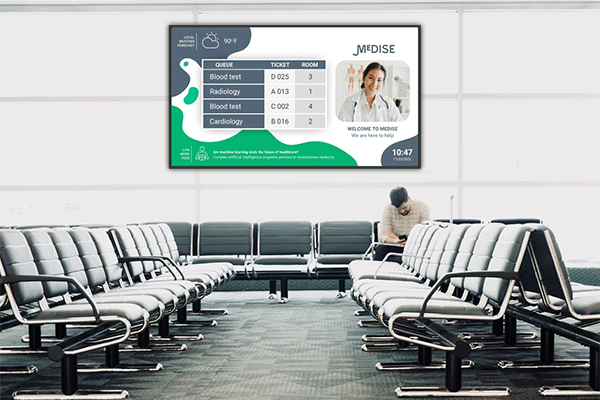
AusSport offers a great range of medical & hospital digital signage to suit just about every professional business. If you are a busy General, Dental or Allied Health Practice or a gym and you have important health advice or announcements for your clients and patrons then we have the right solution for you.
We only use high quality, reliable LED or TV suppliers, we have the software and control systems to ensure you and your staff always are on top of what displays on your outdoor or indoor screens.
Choose from the categories below to view our range or contact the friendly AusSport team today for a fast quote or advice.
We supply, deliver and install to save you all the hard work OR if you prefer we can advise you on the install process.
Features include:
An LED sign (sometimes called an LED display) is an electronic sign consisting of a matrix of individual light emitting diodes (LED) that form image, text or video. An electronic current passes through the LED and visible light comes from the LED.
When the LED pixels are placed very close together, from relatively far distances, the human eye can’t see the gaps between pixels, which delivers quality images with minimum pixelation. LED brightness and colour is very eye catching, which is important for outdoor signs.
Yes and No
An LED screen displays video or broadcast images just like a TV does so in that sense it is the same. The big difference is in brightness. LED screens are orders of magnitude brighter than a TV.
Screen brightness is measured in nits. Outdoor signs and screens can be 10000 nits and indoor LED screens can be 5-6000 nits. Compare that to current TV technology where 1000 nits is claimed by some manufacturers.
This means an LED screen can be seen from a distance away and all lighting conditions including full sun.
A pixel is a physical point in an image i.e. one single dot.
Pixels are the combined tiny dots of light or LEDs that make up the whole of your sign. Pixel pitch is the distance between these tiny dots. The nearer the pixels, the sharper and more vibrant your display will be.
Pixel pitch is the distance between pixels (the tiny dots of light that make up your sign). The nearer the pixels, the sharper and more vibrant your display will be. A fine pixel pitch means you can clearly share even more captivating content.
Ideally an LED sign will have a pixel pitch of P6 (6mm between pixels) or even better P4 (4mm between pixels).
An LED sign can technically be any size. LEDs are built into cabinets of approximately 1.2m x 1m. This dictates how small a screen can be. From there the sky is the limit. The cabinets are bolted together and then cabled together to form a complete screen.
As LED signs grows in size, the supporting frame and structure needs to become bigger and more complex.
With each additional cabinet there is also an additional power requirement and cabling from the power supply.
The ideal location is where the intended audience will have the maximum amount of time viewing the sign face-on. Often that ideal location is just not available – infrastructure, available power, trees all impact on where the sign can go. Also, if you have an existing sign then it is the obvious place to install an LED sign.
Street facing signs should be angled toward the oncoming traffic, clear of trees and road signs that might obstruct the viewing. Stand as close as possible to where the viewers will be and visualise how easily the sign will be seen. Consider also the impact on nearby residents who may not appreciate a dazzling display!
This is an important question because there are a number of rules and regulations surrounding the use of LED signs and screens when they are facing a roadway.
The main restriction is that no video can be shown to distract drivers. This also means that the rate of transition from one fixed image to another cannot be less than 5 seconds (this may vary in different states or local government areas)
At AusSport we have become very familiar with the regulations over the years so feel free to contact us if you have a specific question.
A key requirement for LED signs is that they can be read and understood by viewers. When those viewers are in moving vehicles then there are only a few seconds to get the message across. The larger a sign is the more likely the message will be received. This is why motorway signage is so huge in populated areas.
Our experience suggests that on a multi or single lane street then the minimum sign should be approximately 1.9m x 1m and a recommended size is 2.4m x 1.6m.
The sign is connected to a content management system (CMS). The CMS allows you to upload images, text, even video to the sign. It also allows you to schedule when to display any image or when to make the sign turn off at night or when not required.
The CMS is internet based and communicates directly with a computer built into the sign. This means you can manage your sign messaging from anywhere in the world.